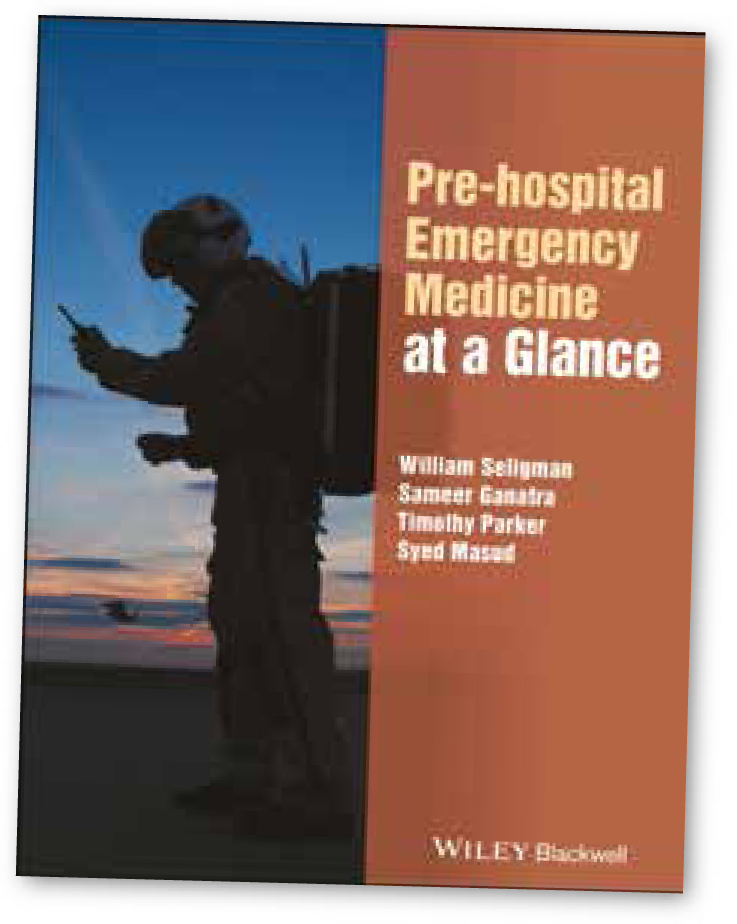This series of books is likely to be familiar to many students as a good foundation for further study. Pre-hospital Emergency Medicine at a Glance covers the essentials in an easy-to-digest formula. This volume continues the trend of good quality information, covering enough to give readers a firm and solid grounding in the subject of pre-hospital emergency medicine (PHEM).
The book also acts as an aide-memoire for the more experienced health professional. Each segment is illustrated with easily understandable and colourful diagrams, as well as tables with the most relevant information, which is great for quick reference. It is subdivided into six sections:
Like any thorough paramedic textbook, it opens with a section on the history of pre-hospital care, from the biblical Good Samaritan to the modern-day GoodSam App. A chapter is dedicated to considering the mechanism of injury and the energy expenditure of likely injuries. Human factors are included, with a reference to levelling out the management hierarchy to avoid mistakes—lessons learned from the case of Elaine Bromiley, a 37-year-old woman who died as a result of medical errors while being anaesthetised.
Hazardous area, chemical, biological, radiological and nuclear (CBRN) defense and scene safety have a precise section. These include STEPS 1-2-3 Plus, decontamination and how to set up a fending-off zone on a roadside emergency. This section may be particularly pertinent given the expanding range of incidents that paramedics have to respond to; for example, the nerve agent attack in Salisbury on 4 March saw paramedics administer crucial and lifesaving care.
Assessment and management covers the ABCs from primary trauma survey, haemorrhage control, and differentiating between medical and traumatic cardiac arrest—including when these become cause and effect. The section on spinal control makes the salient point that spinal immobilisation is more important than clearing it, as sometimes too much pressure can be put on the necessity of clearing at scene. Many paramedics have carefully immobilised and packaged a patient with bone tenderness at scene prior to administration of analgesia, only for the accident and emergency consultant to immediately remove it all and roll their eyes at the use of a collar on an apparently comfortable patient. However, this comes with the risk that at some point, a patient will be under-packaged and potentially suffer further injury as a result.
The section on special circumstances runs just over three pages. The chapter covers detail on the fundamental differences between the anatomy and physiology of adults, children, pregnant women, and elderly patients.

The paediatric chapter has useful formulae for weight, fluid resuscitation volumes, tubes and defibrillation energy.
The practical skills section covers the ‘juicier’ parts of PHEM:
The emerging use of ultrasound (US) in the form of a FAST scan (focused assessment with sonography in trauma) is introduced. This technique is worth some attention as US machines have now become more portable, cheaper, and are showing a lot of benefits relevant to PHEM—from locating internal bleeds, checking cardiac status, and locating veins for an increased success rate in rapid IV access, shaving vital seconds off the time taken to start replenishing lost blood in patients suffering catastrophic trauma.
The complex problems section includes dealing with major incidents, triaging patients, and how best to set up an incident command. Expedition and event medicine are similar in that both require risk assessment, planning, and the right team with the right training, communication, and equipment. Military PHEM covers the levels of medical equipment and specialty, from the individually issued (such as tourniquets and morphine administration) to the enhanced pre-hospital emergency care teams comprising consultants in anaesthetics and emergency medicine. The sixth section on careers in PHEM for emergency medics and paramedics is very brief, running across two pages.
This volume is likely to be well-received as a concise, well-thought-out reference that contains both up-to-date and emerging techniques used by ambulance personnel and specialist PHEM practitioners. It assumes a certain level of medical knowledge, but is not aimed so high that only fully qualified critical care paramedics will be able to read it. It will give a solid foundation in PHEM to build on for those interested in pursuing a career in air ambulances, and directs readers to further examine several subjects where the authors feel they would benefit from a deeper understanding. Paramedics with more than a few years of experience may find this book a bit basic but would be able to use it as a useful refresher.

